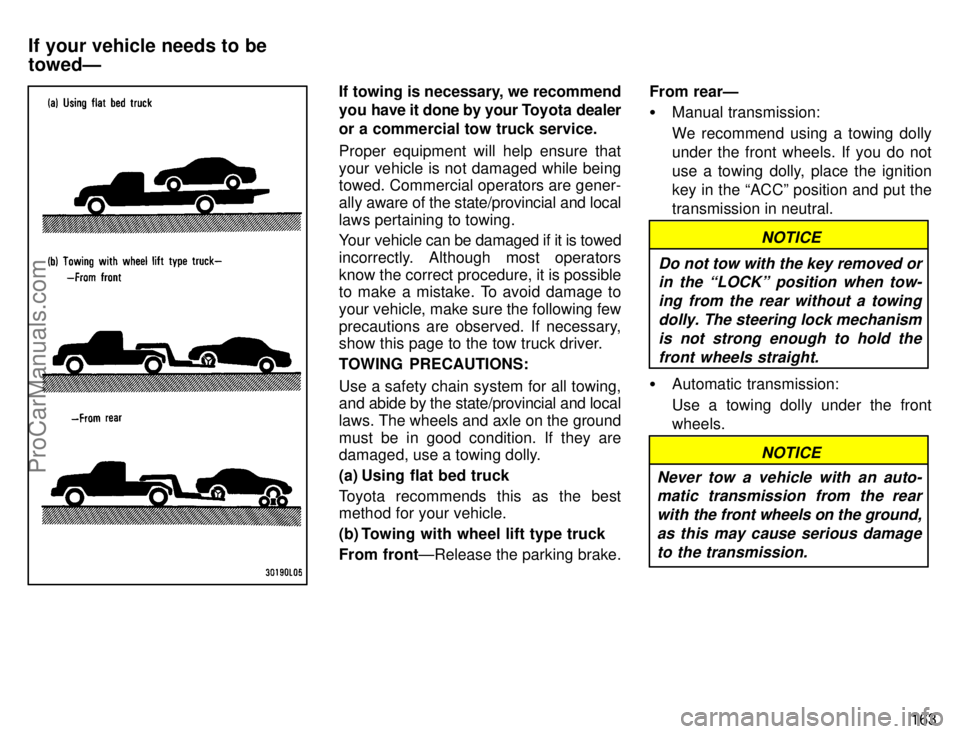Page 169 of 226

163
If towing is necessary, we recommend
you have it done by your Toyota dealer
or a commercial tow truck service.
Proper equipment will help ensure that
your vehicle is not damaged while being
towed. Commercial operators are gener-
ally aware of the state/provincial and local
laws pertaining to towing.
Your vehicle can be damaged if it is towed
incorrectly. Although most operators
know the correct procedure, it is possible
to make a mistake. To avoid damage to
your vehicle, make sure the following few
precautions are observed. If necessary,
show this page to the tow truck driver.
TOWING PRECAUTIONS:
Use a safety chain system for all towing,
and abide by the state/provincial and local
laws. The wheels and axle on the ground
must be in good condition. If they are
damaged, use a towing dolly.
(a) Using flat bed truck
Toyota recommends this as the best
method for your vehicle.
(b) Towing with wheel lift type truck
From frontÐRelease the parking brake.From rearÐ
�Manual transmission:
We recommend using a towing dolly
under the front wheels. If you do not
use a towing dolly, place the ignition
key in the ACCº position and put the
transmission in neutral.
NOTICE
Do not tow with the key removed or
in the LOCKº position when tow-
ing from the rear without a towing
dolly. The steering lock mechanism
is not strong enough to hold the
front wheels straight.
�Automatic transmission:
Use a towing dolly under the front
wheels.
NOTICE
Never tow a vehicle with an auto-
matic transmission from the rear
with the front wheels on the ground,
as this may cause serious damage
to the transmission.
If your vehicle needs to be
towedÐ
ProCarManuals.com
Page 170 of 226
164
(c) Towing with sling type truck
NOTICE
Do not tow with sling type truck,
either from the front or rear. This
may cause body damage.
If towing service is not available in an
emergency, your vehicle may be tem-
porarily towed by a cable secured to
one of the emergency towing eyelets
under the front of the vehicle.
A driver must be in the vehicle to steer it
and operate the brakes.
Towing in this manner may be done only
on hard-surfaced roads for a short dis-
tance and at low speeds. Also, the
wheels, axles, drive train, steering and
brakes must all be in good condition.
Before towing, release the parking brake
and put the transmission in neutral
(manual) or Nº (automatic). The key must
be in ACCº (engine off) or ONº (engine
running).
CAUTION!
If the engine is not running, the
power assist for the brakes and
steering will not work so steering
and braking will be much harder
than usual.
ÐEmergency towing
ProCarManuals.com
Page 171 of 226

165
If you cannot shift the selector lever
out of Pº position to other positions
even though the brake pedal is de-
pressed, use the shift lock override
button as follows:
1. Turn the ignition key to LOCKº
position. Make sure the parking brake
is on.
2. Pry up the cover with a flat-bladed
screwdriver or equivalent.3. Insert the screwdriver or equivalent
into the hole to push down the shift
lock override button. You can shift out
of Pº position only while pushing the
button.
4. Shift into Nº position.
5. Insert the cover.
6. Start the engine. For your safety,
keep the brake pedal depressed.
Be sure to have the system checked by
your Toyota dealer as soon as possible.Many Toyota dealers can make a new
key if you can give them the key num-
ber.
See the suggestion given in Keysº in
Chapter 1-2.
If your keys are locked in the vehicle and
you cannot get a duplicate, many Toyota
dealers can still open the door for you, us-
ing their special tools. If you must break a
window to get in, we suggest breaking the
smallest side window because it is the
least expensive to replace. Be extremely
cautious to avoid cuts from the glass.
If you lose your keys If you cannot shift automatic
transmission selector lever
ProCarManuals.com
Page 179 of 226

173 Tire surface and wheel nuts
Check the tires carefully for cuts, damage
or excessive wear. See Chapter 7-2 for
additional information. When checking
the tires, make sure no nuts are missing,
and check the nuts for looseness. Tighten
them if necessary.
Tire rotation
Rotate the tires every 12000 km (7500
miles). See Chapter 7-2 for additional in-
formation.
Fluid leaks
Check underneath for leaking fuel, oil, wa-
ter or other fluid after the vehicle has been
parked for a while. If you smell fuel fumes
or notice any leak, have the cause found
and corrected immediately.
Doors and engine hood
Check that all doors including trunk lid op-
erate smoothly and all latches lock se-
curely. Make sure the engine hood secon-
dary latch secures the hood from opening
when the primary latch is released.
INSIDE THE VEHICLE
Items listed below should be checked
regularly, e.g. while performing peri-
odic services, cleaning the vehicle,
etc.Lights
Make sure the headlights, stop lights, tail
lights, turn signal lights, and other lights
are all working. Check headlight aim.
Service reminder indicators and warn-
ing buzzers
Check that all service reminder indicators
and warning buzzers function properly.
Steering wheel
Be alert for changes in steering condition,
such as hard steering or strange noise.
Seats
Check that all front seat controls such as
seat adjusters, seatback recliner, etc. op-
erate smoothly and that all latches lock
securely in any position. Check that the
head restraints move up and down
smoothly and that the locks hold securely
in any latched position. For folding-down
or swing-up rear seatbacks or rear seat
cushion, check that the latches lock se-
curely.
Seat belts
Check that the seat belt system such as
buckles, retractors and anchors operate
properly and smoothly. Make sure that the
belt webbing is not cut, frayed, worn or
damaged.Accelerator pedal
Check the pedal for smooth operation and
uneven pedal effort or catching.
Clutch pedal
Check the pedal for smooth operation.
Brake pedal
Check the pedal for smooth operation and
that the pedal has the proper clearance.
Check the brake booster function.
Brakes
At a safe place, check that the brakes do
not pull to one side when applied.
Parking brake
Check that the lever (lever type) or pedal
(pedal type) has the proper travel and
that, on a safe incline, your vehicle is held
securely with only the parking brake ap-
plied.
Automatic transmission Parkº mech-
anism
Check the lock release button of the se-
lector lever for proper and smooth opera-
tion. On a safe incline, check that your ve-
hicle is held securely with the selector
lever in Pº position and all brakes re-
leased.ProCarManuals.com
Page 218 of 226

212 MANUAL TRANSAXLE
Oil capacity, L (qt., Imp. qt.):
2.6 (2.7 , 2.3)
Oil type:
Multipurpose gear oil API GL-4 or
GL-5
Recommended oil viscosity:
SAE 75W-90
AUTOMATIC TRANSAXLE
Automatic transmission
Fluid capacity (drain and refill),
L (qt., Imp. qt.):
5S-FE engine Up to 2.5 (2.6, 2.2)
1MZ-FE engine Up to 3.5 (3.7, 3.1)
Fluid type:
Automatic transmission fluid
DEXRON
[-II
Differential
Fluid capacity, L (qt., Imp. qt.):
5S-FE engine
1.6 (1.7, 1.4)
1MZ-FE engine
0.85 (0.9, 0.7)Fluid type:
Automatic transmission fluid
DEXRON
[-II
BRAKES
Minimum pedal clearance when depressed
with the pressure of 490 N (590 kgf, 110 lbf)
with the engine running, mm (in.):
70 (2.8)
Pedal freeplay, mm (in.):
1'6 (0.04'0.24)
Pad wear limit, mm (in.):
1.0 (0.04)
Lining wear limit, mm (in.):
1.0 (0.04)
Lever type parking brake adjustment
when pulled with the force of 196 N (20
kgf, 44 lbf):
5Ð8 clicks
Pedal type parking brake adjustment
when depressed with the pressure of 294
N (30 kgf, 66.1 lbf):
3Ð6 clicks
Fluid type:
SAE J1703 or FMVSS No. 116 DOT 3
STEERING
Wheel freeplay:
Less than 30 mm (1.2 in.)
Power steering fluid type:
Automatic transmission fluid DEX-
RON
[-II or -III
ProCarManuals.com
Page:
< prev 1-8 9-16 17-24